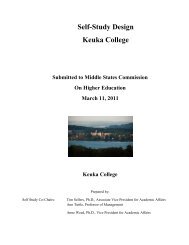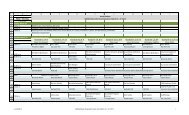final version of the self-study document - Keuka College's Middle ...
final version of the self-study document - Keuka College's Middle ...
final version of the self-study document - Keuka College's Middle ...
You also want an ePaper? Increase the reach of your titles
YUMPU automatically turns print PDFs into web optimized ePapers that Google loves.
events, College branding, transfer enrollment, alumni partnerships, and accepted contacts, as<br />
described in Appendix 5.4 Enrollment Management Retreat Priorities 2009. (Due to <strong>the</strong><br />
significant restructuring <strong>of</strong> <strong>the</strong> Enrollment Management function in 2011-2012, a more recent<br />
enrollment plan is not yet available.)<br />
In recent years, <strong>the</strong> admissions team has embraced <strong>the</strong> use <strong>of</strong> various Internet marketing<br />
technologies to eliminate incremental costs associated with tertiary market recruitment. College<br />
fairs and high school visits in <strong>the</strong>se regions have become more focused on students most likely to<br />
value <strong>the</strong> educational experience provided by <strong>Keuka</strong> College. Out-<strong>of</strong>-state enrollment for firstyear<br />
students remains a growth opportunity. Most notably with regard to improving enrollment<br />
numbers, in Fall 2012, <strong>the</strong> College adopted use <strong>of</strong> <strong>the</strong> Common Application which has led to a<br />
significant increase in <strong>the</strong> number <strong>of</strong> applications for <strong>the</strong> Fall 2013 academic year, although it is<br />
too early to determine if this will lead to a higher enrollment yield and/or allow for greater<br />
institutional selectivity. Increasing <strong>the</strong> number <strong>of</strong> students from underrepresented groups also<br />
remains an important institutional goal, and although <strong>the</strong> table below shows an upward trend<br />
from 2004-2005, <strong>the</strong> College needs to improve its efforts to recruit and admit students from<br />
underrepresented groups.<br />
Table 5.1 Traditional program percentage <strong>of</strong> students classified as minority groups<br />
2004- 2005- 2006- 2007- 2008- 2009- 2010- 2011-2012<br />
2005 2006 2007 2008 2009 2010 2011<br />
7.9 9.35 10.45 9.7 10.39 10.48 11.09 Data not available—<br />
data migration issues<br />
Notwithstanding <strong>the</strong> good work <strong>of</strong> <strong>the</strong> Admissions <strong>of</strong>fice, recruitment for <strong>the</strong> traditional program<br />
has faced a number <strong>of</strong> challenges and enrollment is relatively stagnant, as reflected in Chart 5.2.<br />
In addition to <strong>the</strong> declining population <strong>of</strong> high school graduates in its principal recruiting areas<br />
noted above, <strong>the</strong> College lacks strong brand presence in its region. The most recent marketing<br />
analysis (December 2008), “Academic Program Marketability Assessment Report,” by <strong>the</strong><br />
consulting firm STAMATS, pointed out that <strong>the</strong> college lacks sufficient recognition by<br />
prospective students: “<strong>Keuka</strong> must embark on a major brand clarification and awareness effort in<br />
its primary recruitment marketplace. It is largely an unknown entity in its primary markets with<br />
high school students” (Appendix 5.5 STAMATS 2008 Report, p. 36). Their recommendation for<br />
a broader brand awareness campaign to improve <strong>the</strong> promotion <strong>of</strong> <strong>the</strong> overall College is one that<br />
has <strong>the</strong> support <strong>of</strong> <strong>Keuka</strong>’s new president; in fact, <strong>the</strong> executive leadership <strong>of</strong> <strong>the</strong> College has<br />
begun to develop <strong>the</strong> process for a unifying, sustainable brand strategy that will drive all<br />
elements <strong>of</strong> <strong>Keuka</strong> College’s marketing program and build on <strong>the</strong> distinctive qualities <strong>of</strong> each<br />
division - <strong>the</strong> traditional campus liberal arts, pre-pr<strong>of</strong>essional, and graduate programs, <strong>the</strong><br />
accelerated studies for adults program, and global education. Completion <strong>of</strong> a branding and<br />
marketing strategy would provide <strong>the</strong> College a larger and stronger inquiry and applicant pool,<br />
and improved enrollment/retention would yield needed revenues. Moreover, <strong>the</strong> executive<br />
leadership recognizes <strong>the</strong> need for a stronger web presence and enhanced website content and<br />
improved navigation to support recruitment efforts across all its program deliveries and formats.<br />
<strong>Keuka</strong> also seeks to increase its share <strong>of</strong> transfer students in <strong>the</strong> traditional program, for this<br />
could be a significant growth opportunity, given <strong>the</strong> increase <strong>of</strong> students attending community<br />
colleges for <strong>the</strong>ir first two years. Transfer enrollment over <strong>the</strong> last five years has had a yield<br />
Page 5 <strong>of</strong> 39 Chapter 5: Admissions, Retention & Support




